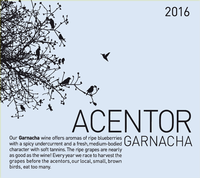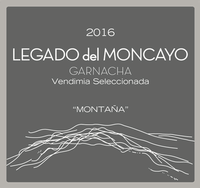In most American families, altering the menu for Thanksgiving Dinner would be unthinkable at best…and downright heretical at worst. I can understand that, I suppose, and will agree to consider this under the heading of “venerable tradition” rather than “mindless repetition.” Still, if I had my way, the Franz family would have kicked the stupid turkey to the curb decades ago in favor of a roast goose, which is a vastly more interesting bird.
But I don’t have my way, on account of the fact that my 97-year-old father has seniority. I feel so lucky to have him with us that I will–yet again–be cheerfully roasting up yet another stupid turkey this week. To be entirely candid, however, a lot of my cheerfulness will stem from the fact that I can at least change up the wine we’ll be drinking.
If you are not adamantly attached to Beaujolais or Pinot Noir or some other family staple, then please consider joining me by branching out to try a juicy, delicious, versatile Garnacha from  Aragón in Spain. Although they are just a bit deeper in flavor and gutsier in structure than the stand-bys, these reds are just as fruity and easy for novices to enjoy as “the usual suspects.”
Aragón in Spain. Although they are just a bit deeper in flavor and gutsier in structure than the stand-bys, these reds are just as fruity and easy for novices to enjoy as “the usual suspects.”
Aragón Garnacha’s welcoming approachability an important virtue, as the reality of things is that many Americans drink wine very occasionally, with Thanksgiving being among the few occasions. We don’t want to scare off newbies when we’ve got a rare chance to convert them, and we certainly don’t want to let them harm themselves…as a big, foamy, bloating beer with Thanksgiving dinner could blow up a guest like a human piñata.
You may be more familiar with Garnacha under its French name, Grenache, and in France, the grape is the predominant component in most bottles of Côtes-du-Rhône. These wines are also excellent candidates for Thanksgiving, and indeed better ones than Beaujolais or Pinot on a dollar-for-dollar basis. (Sure, if you’ve got $75 to spend on well-aged Pinot from Volnay or Chambolle-Musigny in Burgundy, that’s exactly what you should optimally do, but that’s simply not in the cards for most families.) Still, I think Spanish Garnacha is even better with this meal than Côtes-du-Rhône, as Garnacha usually has a flavor profile that is more purely fruity, and which therefore pairs more successfully with the vast array of flavors and textures in a typical Thanksgiving dinner.
With only a few days to go before the holiday, I should back up my general advice with some specific suggestions. Below you’ll find reviews of three completely delicious examples at extremely attractive prices. They are ordered from lighter to fuller in body, so the one at the top of the list might be preferable with white turkey meat or for meals with fairly light stuffing and gravy. If you prefer dark meat and prepare a hearty stuffing and deeply flavored gravy based on a reduction technique, then look farther down the list. Or–at these prices–just go totally nuts and try all three:
Legado del Moncayo (Campo de Borja, Aragón, Spain) Garnacha 2017 ($14, imported by Grapes of Spain): Simple, but simply delicious, this is a very pure rendering of Garnacha that doesn’t come off as grapey or obvious, which is exactly the danger for this grape in this style. Subtle savory undertones lend complexity and interest, and there’s enough acidity to keep it fresh, and enough tannin to offer framing. Basically a perfect, risk-free wine for Thanksgiving, this delivers roughly the juicy, open fruit flavors associated with good, standard Beaujolais, except that the flavors are both deeper and more lasting. 88
Acentor (Calatayud, Aragón, Spain) Garnacha 2016 ($14, Grapes of Spain): With an additional year of aging by comparison to Garnacha wines from the 2017 vintage, this shows slightly toned-down fruit and modestly tuned-up savory notes, but is still full of fruity fun. Red berry tones join cherry flavors, and the soft tannins lend a bit of backbone without imparting any astringency or hardness to the finish. In a word: Yum. 90
 the right balance points vintage after vintage. Sourced from a higher elevation vineyard site than Legado del Moncayo’s “regular” bottling, it shows more concentrated, gutsier fruit, with a more notable suggestion of a little wood influence. But then again, any wood influence is just “suggested,” and the fruit still stands at center stage–albeit with unusually good structure for a wine in this price category. The flavors recall both red and black cherries, with just a hint of spice and a subtle savory layer running beneath the fruit flavors. Whereas the “regular” Legado del Moncayo is suited to poultry or fish, this starts in terms of suitability at poultry and works its way up to pork, veal or duck…and would be entirely satisfying with a burger. 91
the right balance points vintage after vintage. Sourced from a higher elevation vineyard site than Legado del Moncayo’s “regular” bottling, it shows more concentrated, gutsier fruit, with a more notable suggestion of a little wood influence. But then again, any wood influence is just “suggested,” and the fruit still stands at center stage–albeit with unusually good structure for a wine in this price category. The flavors recall both red and black cherries, with just a hint of spice and a subtle savory layer running beneath the fruit flavors. Whereas the “regular” Legado del Moncayo is suited to poultry or fish, this starts in terms of suitability at poultry and works its way up to pork, veal or duck…and would be entirely satisfying with a burger. 911
